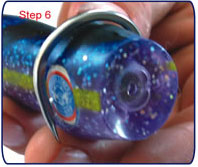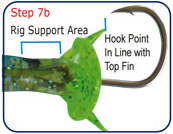PAKULA ARCHIVES
The products on this page are Legacy Products that are no longer in production.
Pakula Dojo Peche Articles
{slider [yjsgfa name="fa fa-refresh"] Guide to Help Understand Pakula Dojo Peche Hybrids |closed}
Guide to Help Understand Pakula Dojo Peche Hybrids
This is a very detailed guide to what is a totally new tool for fishing. The following pages will help you understand the concepts of the lures, how to rig and how to use these revolutionary and very exciting lures to add to your fishing arsenal.
The Hybrid Concept: The Hybrid has its roots from many areas including skirted lure trolling heads, fresh and salt water soft plastics, metal lures and even several dead bait rigging systems. Aspects of all of these have been combined, resulting in an incredibly versatile and effective tool to catch many species of fish using just about any style of artificial bait presentation. It is so new that we have a Patent Pending and found that many aspects of the lure are so revolutionary that some explanations are needed.
Hybrid Jargon: Even though lures have been around for a very long time there are very few words or descriptions that adequately describe parts of lures and their purpose. Plus these hybrids have totally new design aspects that you may wish to know about and understand.
Pakula Dojo Peche® Hybrids are made from a tough flexible PVC material very similar to those used in making tough dog toys. They are certainly not indestructible, but are tougher than many other PVC lures on the market.

Head and Head Angles: The lure heads are very similar to well known effective Pakula Trolling Lure heads and result in similar actions and performance. The head angles and proportions give the lure its characteristic action. The sharper the angles the easier the lure head will cut through the surface of the water which is preferred in calm conditions and in lures run further back with the line at a low angle to the surface. The rounder the angles the harder it is to cut through the surface of the water which is preferred in rougher choppier conditions and in lures run closer back with the line at a higher angle to the surface.
Lumo Logo Eye: These are the traditional Pakula Eyes. The Lumo is luminescent and is very bright during the day and glows in the dark. The Pakula logo is on all eyes so you know it's a Pakula Lure.
Body Back and Body Belly: The body gives the lure bulk and supports the skeleton, Deadlock system and keel.
Keel: The lead weight keel has triple purposes: firstly to add weight to the lure to help keep the lure down on the surface and add weight for casting, secondly it is positioned so that the lure sinks more horizontally like a live bait fish rather than head or tail first like most other lures and thirdly, most importantly to keep the lure and hook point upright to maximise hook up rates.

Tail and Tail Ribs: The tapered tail is ribbed to increase the tail action and shaped to minimise the hook flicking back and fouling the lure body. The Tail Ribs also create extra vibration to stimulate the fish and also causes an increase in smoke trail (bubbles released by the lure as it breaks through the surface and dives again).
Rig Support Area: This is a thicker area of the tail to hold the hook in position by squeezing on the crimp, chaffing gear (tubing of either plastic or spring) hook eye and shank.
Tail Support and Action Tail: The tail supports hold the round action tail out so that water pressure doesn't just fold it back helping the tail remain active at higher speeds. The action tail also gives fish a clear target to attack.
Top and Bottom Fin: The fins support the Action Tail from the rear so that water pressure doesn't just fold it back helping the tail remain active at higher speeds. The fins also give the lure a more natural profile. The tail fins also extend the lure so that rigs where the hook eye may be tournament legal. You should check with individual tournament judges. The lures come pre-rigged with the eye of the hook inside the Rig Support Area.
Dojo Peche Hook: These hooks have been specifically designed for Hybrids. The short shank and wide gape gives the lure greater freedom of action. Normal J hooks greatly restrict the lures action. The shape of the point and barb are designed to maximise hook up rates using the great variety of methods that the Hybrids will be used with. They are a hard 402J2 stainless steel. They are a fine gauge hook to maximise hook penetration, but being that fine they may not be suitable for line classes where drag settings of over 15kg are used.

{slider [yjsgfa name="fa fa-refresh"] The Versatility of Pakula Dojo Pehe Hybrids}
The Versatility of Pakula Dojo Pehe Hybrids
You can:
The Dogo Pech Hybrids were designed as a game fishing lure but have proven to be be a very versatile lure. It's certainly exciting to have a lure that can be used in so many ways to target so many species.

{slider [yjsgfa name="fa fa-refresh"] Pakula Dojo Peche Hybrid Construction}
Pakula Dojo Peche Hybrid Construction
| The construction of Skooners and Destroyers are very simmilar. Only the head shapes are different. |
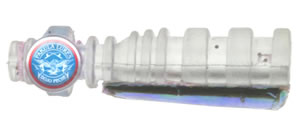 |
| This is the internal skeleton made from High Impact PVC.The foil covered lead keel on the bottom of the skeleton will keel the lure and hook maximising hook-ups and allow you to fish the lure as deep as you want. It will cast like a bullet.The skeleton supports a tough but flexible PVC skin that is made from the same tough PVC that dog's toys are made from. Dojo Peche® Hybrids are tough enough to use on heavy tackle game gear! |
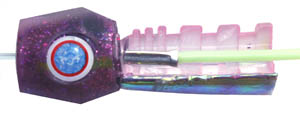 |
| The internal skelleton has a tapered internal tube that is just soft enough to act as a crimp holder to keep you hook positioned where you want it to stay which is usually hook point up on the opposite side to the foil covered keel. To introduce the Dojo's it was decided to give you something that is easy to identify. |
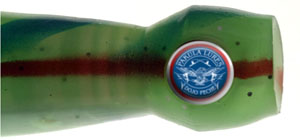 |
| The Skooner has a Cockroach shaped head with the now Traditional Pakula Logo Eye. It's well recognised that the shape is one of the best trolling head shapes of all time, and is also a common popper shape. |
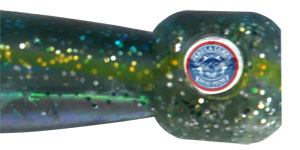 |
| The Destroyer has a Beer Barrel shaped head with the now Traditional Pakula Logo Eye. It's well recognised that the shape is one of the best trolling head shapes of all time for normal to high speed trolling and traction in very rough conditions. |
 |
| From the side the Dojo Hybrid has normal baitfish profile. |
 |
| From the top view you can see the cut outs that maximise tail action and each of the cut outs put out their own vibrations at all speeds and increase the smoke trail at faster speeds. |
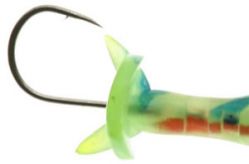 |
| The tail has a massive supported paddle that is curved to catch as much water as possible to impart maximum realistic action and at faster speeds and imaprt a great bubble trail.You may have followed along and now notice this is a triple action lure with the head, side cuts and tail all causing vibration and their own smoke trails at speeds as low as 2.5 knots.Note that when the Dojo Hybrid isn't smoking, it's swimming so no matter what you do with it, it is working!The tail also acts as a weed guard in estuary, river and impoundment fishing, or wherever weed and flotsam is a problem. In these applications a smaller hook would be used, or even a treble.The tail flap will easily fold away into the hook bend to allow for a clean hook-up. The tail section will also stretch so if a fish grabs the lure in front of the flap it will stretch and the hook will find it's mark, as the rig is supported by the skeleton. |
 |
| The compleate rigged lure has a great realistic bait fish profile. |
 |
| From above and below the Hybrids also have a realistic bait fish profile. |
 |
| Just like a game fishing trolling lure the Dojo Hybrids are designed to slide up the leader so that the fish cannot use the weight of the lure to throw the hook. This is just as applicable to Barra, Trout, Saratoga as it is to Marlin. Also note that the crimp above the chafe tubing locks into the internal skeleton to keep the hook in position. |

{slider[yjsgfa name="fa fa-refresh"]Guide to Help Understand Rigging Pakula Dojo Peche Hybrids}
Guide to Help Understand Rigging Pakula Dojo Peche Hybrids
Rigging a Pakula Dojo® Peche Hybrid is very similar to rigging a standard skirted lure as it uses some of the same systems, but has in addition a method to help maintain the hook in the preferred position. All Hybrid lures are sold pre-rigged so all you really have to do is copy the rig it comes with. However it is always better if you can understand the systems and concepts so you can vary the rig to your own specifications should you want to. For example you may wish to use a lighter leader than supplied, or a different hook set up. Once you read the following you'll be able to vary your rigs without compromising the lure action and fish catching ability. Or you just may be someone who only trusts the rigs they make themselves, and don't trust pre-rigged tackle.
To help understand the methods used to rig these new lures we'll run through the construction that is important for rigging.

The Leader:The leader supplied with the lure is high quality Japanese leader. The leader should be relative to the line class you are using and the fish you are targeting. In general the lighter the leader the more fish you will catch. A sign of using leader that is too heavy for the lure is getting strikes resulting in scuff marks on the leader in front of the lure. This happens because all leaders vibrate, and in the case of surface lures such as Pakula Skirted Lures and Hybrids the leaders also have bubble trails.If the leader is too thick the leader restricts the action of the lure and has enough vibration and smoke trail to look like part of the lure and is then attacked by the fish resulting in no hook up or a foul hooked fish in the eye or in the head area.
 The Skeleton: The Skeleton is made from a very tough slightly flexible PVC and has many functions. It supports the whole lure, giving it the strength needed in a lure designed to target the monsters of the sea. It also holds the eye platforms so the eyes stick better than they would on the soft plastic. The Skeleton also supports the Keel whose purpose in rigging is to keel the lure and hook so the hook remains in the position required which is usually hook point up as shown.The most important aspect of the Skeleton in regards to rigging is the Deadlock System. The Deadlock Tube holds the Lock Crimp of the leader securely in taking all of the pressure of the lure and leader, exactly the same function as the crimp at the back of the lure head when rigging skirted trolling lures. The tube has a long taper to accommodate the many sizes of crimps that may be used in rigging both heavy and light leaders in the same lure. The purpose of the tube is to hold the crimp tightly so that the hook remains in the position set. The Deadlock Tube is round so that you do not need to line up the crimp with the hook when making the rig.
The Skeleton: The Skeleton is made from a very tough slightly flexible PVC and has many functions. It supports the whole lure, giving it the strength needed in a lure designed to target the monsters of the sea. It also holds the eye platforms so the eyes stick better than they would on the soft plastic. The Skeleton also supports the Keel whose purpose in rigging is to keel the lure and hook so the hook remains in the position required which is usually hook point up as shown.The most important aspect of the Skeleton in regards to rigging is the Deadlock System. The Deadlock Tube holds the Lock Crimp of the leader securely in taking all of the pressure of the lure and leader, exactly the same function as the crimp at the back of the lure head when rigging skirted trolling lures. The tube has a long taper to accommodate the many sizes of crimps that may be used in rigging both heavy and light leaders in the same lure. The purpose of the tube is to hold the crimp tightly so that the hook remains in the position set. The Deadlock Tube is round so that you do not need to line up the crimp with the hook when making the rig.
It is important to note that the crimp on the leader, the Lock Crimp takes all the forces of the lure and rig when the lure is pulled through the water. This allows the leader and hook below the Lock Crimp to have maximum freedom of action allowing the tail to move freely as it was designed to do.The Leader Tube:The Leader Tube runs the full length of the lure. The more flexible the rig the better the lure will perform, so it is important to keep this mind when rigging the lure. The heavier or stiffer the leader between the Lock Crimp and hook the more the lure action will be retarded. The
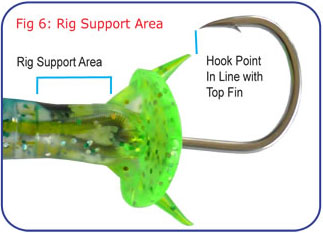
lure comes pre-rigged to give maximum action using a leader that should cope well with the average fish encountered using the lure size it is rigged on. There are many other rigging options, some of which will be explained later in these articles.
Rig Support Area: The Leader Tube is narrower at this section to grip the Hook Crimp, chaffing gear (spring or tubing) hook eye and hook shaft to hold the hook in position. In situations where the hook and chaffing gear is not as bulky as the original rig you can use a drop of super glue to hold the hook firmly in position. Do not use too much glue as the lure is meant to slide away from the rig so that the fish can not use the weight of the lure to throw the hook. The hook eye and chaffing gear should be positioned within the Rig Support area, with the point of the hook in line and level with the top tail fin.
Dojo Peche® Hook: These hooks have been specifically designed for Hybrids. The short shank and wide gape gives the lure greater freedom of action. Normal J hooks with their extra length greatly restrict the lures action. The shape of the point and barb are designed to maximise hook up rates using the great variety of methods that the Hybrids will be used with. They are a hard 402J2 stainless steel. They are a fine gauge hook to maximise hook penetration, but being that fine they may not be suitable for line classes where drag settings of over 15kg are used. There are certainly alternative hooks and hook arrangements that can be used, some of which are shown in the Rigging Hybrid Section.

{slider [yjsgfa name="fa fa-refresh"] How to Rig Pakula Dojo Peche Hybrids}
How to Rig Pakula Dojo Peche Hybrids
|
All Pakula Hybrids sold are pre-rigged using high quality components, so you can see the correct method of rigging by examining the rig that comes with the lure. There are also basic instructions on the back of the lure's packaging. The leader and hook are the correct size for the average sized tackle used for the relative sized lure. There may be circumstances where you believe that the leader length or thickness or hook set up isn't applicable for your situation. Or you may simply not trust pre-rigged items and prefer to rig your tackle yourself. The following will explain how and why the rig is set up the way it is and show you a very quick way of rigging Hybrids to maximise their effectiveness.In this article it is assumed you have read the Guide To Help Understanding Rigging Pakula Dojo PecheHybrids and that you have a basic knowledge of rigging skirted lures and using basic rigging tools. If not please refer to the Pakula web site, www.pakula.com.au article section on Rigging Bits and General Rigging Notes. |
|||
|
|
|||
|
Step 1: When you cut your leader allow for the length of the lure plus an extra 6 inches or 150mm. Lay the hook end along side the lure and leave the extra 6 inches / 150mm out past the end of the lure. Position a crimp so that it's upper edge is level with the back of the head where it meets the lure body. This is where the Deadlock Tapered Tube is inside the Skeleton. |
|||
|
|
|||
|
Step 2: The Lock Crimp should be big enough to lock inside the tapered tube and not small enough to pull through the front of the lure. Generally the same size crimp that you will use for the hook will be the right size. As with all crimping you should have a snug fit. In this case as shown you may need to put a small piece of leader in the crimp to pack it out so that the crimp will not slip after it has been pressed. Note that for crimping nylon you should only use oval aluminium crimps. |
|||
|
|
|||
|
Step 3: Thread the lure on the leader putting the end that will attach to the rod and reel first and the hook end with the crimp on it at the other end. If you have difficulty threading the leader you can use a loop of rigging wire to help pull the leader through quickly and easily. |
|||
|
|
|||
|
Step 4: Hold the lure by the skeleton and body area and pull the leader with at least the force of the drag setting you are likely to use. The crimp will tackle all the force of the lure dragging in the water and the forces of a fish grabbing it. By testing it you can be sure that the crimp will not slip or pull through the lure head. If it does then of course you either have to re press the crimp if it slips or use a larger crimp and pack it with extra bits of line or leader to make sure it will work properly. |
|||
|
|||
|
Step 5: Making sure that the crimp has been pulled tightly into the tapered tube, pinch the leader up tight against where it exits the tail, pull it out and pinch it. This gives you the position of the leader where it leaves the lure. |
|||
|
|
|||
|
Step 6: Choosing the correct sized hook to use with Pakula Hybrids is the same as choosing hooks for skirted trolling lures. The gape of the hook should be about the same size as the diameter of the lure head. Using an over sized hook will adversely affect both Hybrid and Skirted Lure performance. |
|||
|
|||
|
Step 7: Thread the crimp, chaffing gear and hook on the leader. Crimp the hook in position so that it is above the pinched area that marks the end of the lure. The best position is the eye positioned in the Rig Support Area with the hook eye just inside tail supports with the hook point in line with the Top Tail Fin. |
|||
|
|||
|
Step 8: The rig is now ready to position in the lure. Dojo Hooks are very sharp so it is advisable to place the hook around something such as a cleat or in this case a drawer handle. This also makes it easier to line the hook up with the top tail fin. Hold the leader taught and hold the lure around its mid section and ease the lure down the rig setting the Lock Crimp in the Skeleton's tapered tube and also line up the hook in the Rig Support Area. The Rig should fit easily without stretching and deforming the Hybrid's tail. |
|||
|
|
|||
|
Step 9: The Hybrid is now ready to use. Check that the hook is in the correct position as shown in the image. If during use you find that the hook doesn't remain in position you can pack out the hook rig area with electrical tape or a drop of super glue. |
|||

{slider [yjsgfa name="fa fa-refresh"] Hook Point Up}
Hook Point Up
|
It's important to position the hooks of Hybrids so that the point is straight up. Do to the softness of the PVC and action of the lure's tail, hooks may need assistance to remain in position especially at higher trolling speeds. You can use a drop of super glue on the hook eyes to glue them in position. You can also bind a rubber band on the hook shank to help the hook remain in it's optimum position. |
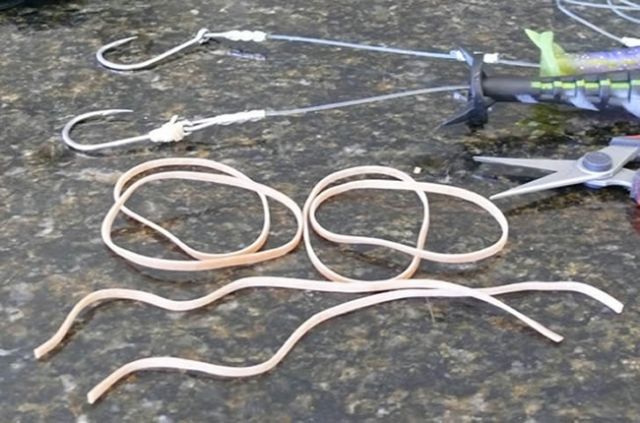 |
| 01: Bits needed: Cut Rubber Bands (here we have used sized 34) scissors, Hybrids |
 |
| 02: Cut a Rubber band and bind it (wrap it around) the hook just below the eye. |
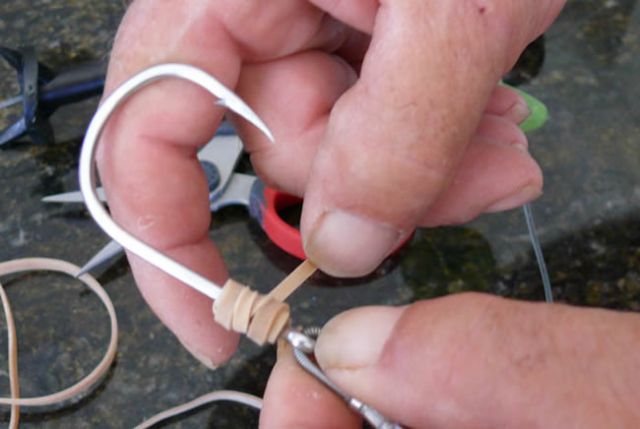 |
| 03: Bind the rubber band in a tight bunch below the hook eye so that the bunch is around the same width as the hook eye. |
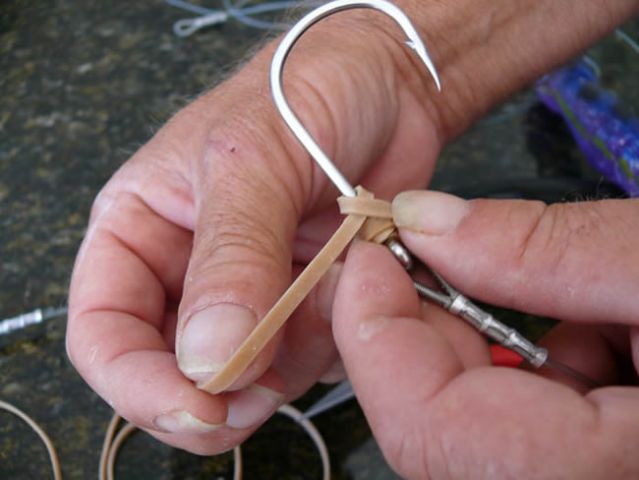 |
| 04: Finish the bind with a half hitch (pass the band end under a wrap) |
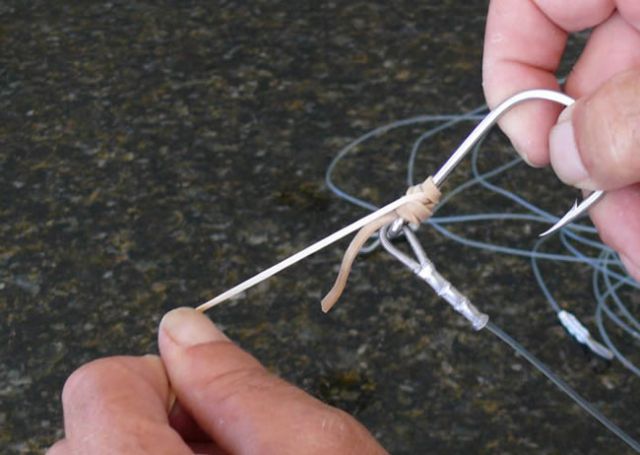 |
| 04: Pull the band end to lock the half hitch into place |
 |
| 05: Trim the ends |
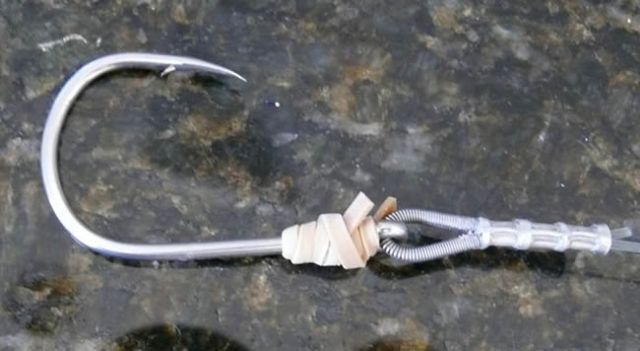 |
| 06: So it will then look like the above photo. |
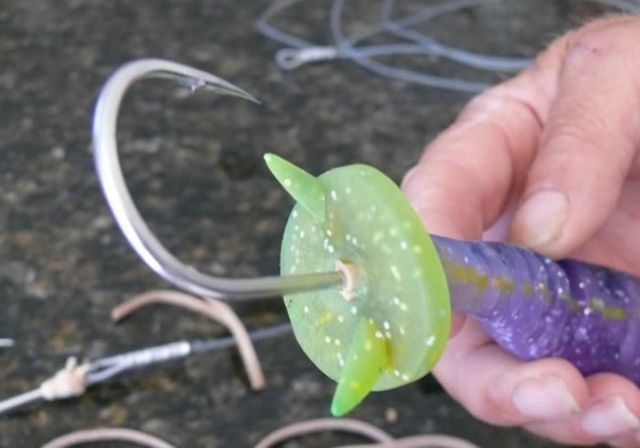 |
| 07: Pull hook into lure so that the hook point is level with the top tail fin. |

{slider [yjsgfa name="fa fa-refresh"] Pakula Dojo Peche Hybid Rigging Alternatives}
Pakula Dojo Peche Hybid Rigging Alternatives
|
The rig Hybrid Lure are pre-rigged with offers consistent high hook-up rates, however there are alternative ways to rig Hybrids that may also give you great results. If you are targeting toothy critters and believe you need protection on the leader to reduce bite offs you can use a wire rig similar to the standard 7x7 cable single hook rig used in skirted trolling lures.Fig 1. The crimp that normally sits behind the skirted lure head will also sit just behind the head in the Hybrids. Fig 2. Tape or shrink tubingm is not required as you want the rig to remain as flexible as possible. To keep the hook point upright when running the lure you can use a rubber band wrapped around the shank of the hook just below the eye that will help keep the hook in the desired position. Fig 1. You can instead or as well use a drop of super glue to hold the hook in position. (specific information in article 'Hook Point Up'. Incorporating a hook one size up to that supplied with the lure has also shown to improve results. Fig 1,2,3. For casting and retrieving you may wish to replace the single hook with a treble. Select a size where the points of the treble will sit outside the diameter of the Action Tail. Unlike a single hook rig, a treble should sit outside the tail of the lure and swing freely. The smaller sized Hybrids are very effective as casting lures when rigged in this manner with a short wire rig, trebles and split rings.Fig 4. If you wish to use the Hybrids jigging in deeper water, in areas of strong current or want the lures to be more stable when trolling you can add a ball sinker to the leader. The ball sinker's diameter should be smaller than the diameter of the lure head. The Hybrids maintain their effectiveness using a sliding sinker on the leader. Fig 5. When the lures are delivered they are rigged with the hook eye inside the lure tail. This complies with IGFA rules. When you change the rigging and are fishing tournaments or club events where rules apply you should check that your rig complies with the rules. Rigs should always be checked for hook sharpness corrosion, abrasion and strength before use regardless of who has prepared them. |
 |
| Fig 1: Standard single hook trolling rig with rubberband to hold hook in position. | |
 |
|
| Fig 2: Clear lure with standard single hook trolling rig showing that crimp locks in behind the head just as in a skirted trolling lure. Note use of hook one size up. | |
 |
|
| Fig 3: Lure rigged with standard single hook trolling rig, also using hook one size up. | |
 |
|
| Fig 4: Casting rig, especially effective with smaller sized Hybrids | |
 |
|
| Fig 5: Sliding Ball Sinker rig |
{slider [yjsgfa name="fa fa-refresh"] Check Rig}
Check Rig
| Part of the routine on my Game Boats has been to check everything that involves catching fish. That includes checking lure rigs regardless of whether a shop, mate, or you make them. It also includes checking rigs such as pre-made ones on the new range of Pakula Lures. It's better to find the problems if any before you hook-up rather than after. |
 |
| 01: The Full set-up to check a rig |
 |
| 02: A snap should be attached to something solid and then snap on the leader. |
 |
| 03 : The hook should ALWAYS face away from you (or anyone else) to minimise the chances of getting hit by the hook if the snap loop fails. Here we are using a set of scales to check the rig. You can also use your index finger around the hooks or anything else you want to. |
 |
| 04: Pull on the rig to make sure that it will hold together under the pressures you expect to use on the rig. |
 |











